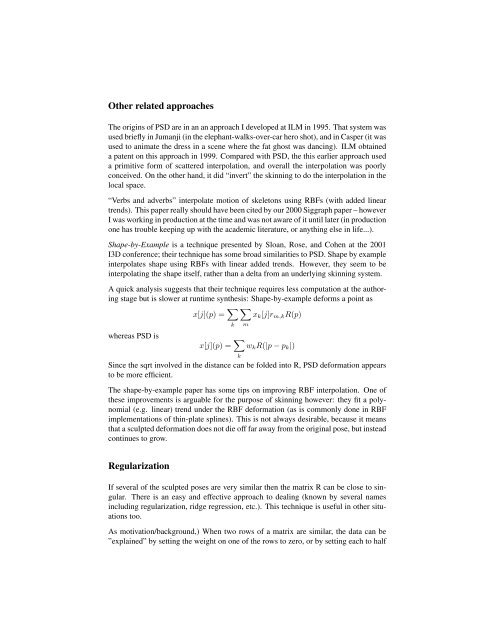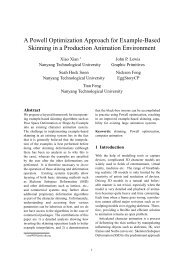Pose Space Deformation Notes - JP Lewis
Pose Space Deformation Notes - JP Lewis
Pose Space Deformation Notes - JP Lewis
You also want an ePaper? Increase the reach of your titles
YUMPU automatically turns print PDFs into web optimized ePapers that Google loves.
Other related approaches<br />
The origins of PSD are in an an approach I developed at ILM in 1995. That system was<br />
used briefly in Jumanji (in the elephant-walks-over-car hero shot), and in Casper (it was<br />
used to animate the dress in a scene where the fat ghost was dancing). ILM obtained<br />
a patent on this approach in 1999. Compared with PSD, the this earlier approach used<br />
a primitive form of scattered interpolation, and overall the interpolation was poorly<br />
conceived. On the other hand, it did “invert” the skinning to do the interpolation in the<br />
local space.<br />
“Verbs and adverbs” interpolate motion of skeletons using RBFs (with added linear<br />
trends). This paper really should have been cited by our 2000 Siggraph paper – however<br />
I was working in production at the time and was not aware of it until later (in production<br />
one has trouble keeping up with the academic literature, or anything else in life...).<br />
Shape-by-Example is a technique presented by Sloan, Rose, and Cohen at the 2001<br />
I3D conference; their technique has some broad similarities to PSD. Shape by example<br />
interpolates shape using RBFs with linear added trends. However, they seem to be<br />
interpolating the shape itself, rather than a delta from an underlying skinning system.<br />
A quick analysis suggests that their technique requires less computation at the authoring<br />
stage but is slower at runtime synthesis: Shape-by-example deforms a point as<br />
x[j](p) = ∑ ∑<br />
x k [j]r m,k R(p)<br />
k m<br />
whereas PSD is<br />
x[j](p) = ∑ w k R(|p − p k |)<br />
k<br />
Since the sqrt involved in the distance can be folded into R, PSD deformation appears<br />
to be more efficient.<br />
The shape-by-example paper has some tips on improving RBF interpolation. One of<br />
these improvements is arguable for the purpose of skinning however: they fit a polynomial<br />
(e.g. linear) trend under the RBF deformation (as is commonly done in RBF<br />
implementations of thin-plate splines). This is not always desirable, because it means<br />
that a sculpted deformation does not die off far away from the original pose, but instead<br />
continues to grow.<br />
Regularization<br />
If several of the sculpted poses are very similar then the matrix R can be close to singular.<br />
There is an easy and effective approach to dealing (known by several names<br />
including regularization, ridge regression, etc.). This technique is useful in other situations<br />
too.<br />
As motivation/background,) When two rows of a matrix are similar, the data can be<br />
”explained” by setting the weight on one of the rows to zero, or by setting each to half







